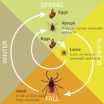Time to move Lyme Disease Awareness Month to April?
Climate warming is leading to earlier spring feeding by blacklegged ticks
2015-04-27
(Press-News.org) (Millbrook, NY) The month of May brings many things, among them Mother's Day, tulips, and Lyme Disease Awareness campaigns. But according to Dr. Richard S. Ostfeld, a disease ecologist at the Cary Institute of Ecosystem Studies in Millbrook, NY, if we want to get a leg up on tick-borne illness we need to become vigilant earlier in the season.
In New York State, the blacklegged ticks that carry Lyme disease and other pathogens are already active in late April. Ostfeld explains: "For more than two decades, we've been monitoring tick activity in the Hudson Valley region and beyond. It's clear that climate warming is leading to earlier spring feeding by nymphal ticks, sometimes by as much as three weeks. While peak nymph activity occurs in May, in some years it's at the beginning of the month."
Paying attention to nymphal tick activity is essential to protecting public health. This tick life stage poses the greatest threat to people. Nymphs are both extremely small - about the size of a poppy seed - and often infected with the bacterium that causes Lyme disease. This stage is also the main carrier of the agents of babesiosis and anaplasmosis. In contrast, larval ticks are born free of these tick-borne pathogens, while feeding adult ticks are often large enough to detect.
Results on the trend toward advanced spring emergence were published this February in the journal Philosophical Transactions of the Royal Society B. Among the paper's findings: nymphal ticks peak in the spring, larval ticks peak in the summer, and both emerge nearly three weeks earlier in warmer years.
As a result, Ostfeld is advocating moving Lyme Disease Awareness month to April. "By encouraging safe behavior, public education campaigns play a real role in reducing the number of people that suffer from Lyme disease and other debilitating tick-borne illnesses. In New York State - and likely throughout the Northeast - we need to begin taking preventative measures before May, as potentially infected nymphal ticks are already on the move."
Research conducted in Nantucket, Massachusetts suggests that educational interventions can lower the incidence of Lyme disease between 20% and 60% depending on the length of time people spend outdoors in areas where ticks are active.
Those hoping the harsh Northeast winter will make for a milder tick season are likely out of luck. Ostfeld explains, "There is no indication that fewer ticks will be a silver lining from the cold winter. We actually expect the opposite. Snow provides ticks with an insulating layer that may be protective."
INFORMATION:
The Cary Institute of Ecosystem Studies is a private, independent, nonprofit environmental research organization located on 2,000-acres in New York's Hudson Valley. Areas of expertise include disease ecology, forest and freshwater health, climate change, urban ecology, and invasive species. The science program is complemented by education, communication, and outreach initiatives.
[Attachments] See images for this press release:


ELSE PRESS RELEASES FROM THIS DATE:
2015-04-27
KNOXVILLE--The monk parakeets that have invaded Europe and North America over the last 40-50 years fortifying their massive communal nests atop utility poles in many urban areas appear to have originated from the same small area in South America, according to a new study.
Considered one of the best speaking parrots, thousands of these bright green birds have been imported for the pet trade, and feral populations began appearing in the United States in the 1960s and in Europe in the 1980s. And yet, these two independent invasions--in the United States and in Europe--appear ...
2015-04-27
(SACRAMENTO, Calif.) -- UC Davis investigators have settled a long-standing controversy surrounding the molecular basis of an inherited disorder that historically affected Ashkenazi Jews from Eastern Europe but now also arises in other populations of Semitic descent, particularly families from Saudi Arabia.
Through a series of elegant experiments, the researchers uncovered the biochemical underpinnings of Canavan disease, a type of leukodystrophy that is an incurable and progressively fatal neurological condition. The UC Davis team identified an abnormally high buildup ...
2015-04-27
COLUMBUS, Ohio - A national survey released today by The Ohio State University Wexner Medical Center shows that most women don't know the risks or symptoms females face when it comes to having a stroke.
The survey of 1,000 women released in time for Stroke Awareness Month in May found that only 11 percent of women could correctly identify pregnancy, lupus, migraine headaches and oral contraception or hormone replacement therapy as female-specific stroke risks.
The survey also found that only 10 percent were aware that hiccups combined with atypical chest pain are among ...
2015-04-27
Astronomers using the National Science Foundation's Very Large Array (VLA) have found a long-sought "missing link" between supernova explosions that generate gamma-ray bursts (GRBs) and those that don't. The scientists found that a stellar explosion seen in 2012 has many characteristics expected of one that generates a powerful burst of gamma rays, yet no such burst occurred.
"This is a striking result that provides a key insight about the mechanism underlying these explosions," said Sayan Chakraborti, of the Harvard-Smithsonian Center for Astrophysics (CfA). "This object ...
2015-04-27
Older women with urinary tract infections who are taking the commonly prescribed antibiotic nitrofurantoin are more likely to experience treatment failure, resulting in a second antibiotic prescription or a hospital visit, than if they received another antibiotic, according to research in CMAJ (Canadian Medical Association Journal).
More than 25% of older adults have low kidney function, and bladder infections are common. Nitrofurantoin is one of the most commonly prescribed antibiotics for bladder and other urinary tract infections, with an estimated 25 million prescriptions ...
2015-04-27
DURHAM, N.C. - Repeated alcohol exposure during adolescence results in long-lasting changes in the region of the brain that controls learning and memory, according to a research team at Duke Medicine that used a rodent model as a surrogate for humans.
The study, published April 27 in the journal Alcoholism: Clinical & Experimental Research, provides new insights at the cellular level for how alcohol exposure during adolescence, before the brain is fully developed, can result in cellular and synaptic abnormalities that have enduring, detrimental effects on behavior.
"In ...
2015-04-27
April 27, 2015--Researchers at Columbia University's Mailman School of Public Health looked at the frequency of nonmedical prescription opioid use and the risk of heroin-related behaviors and found that past-year heroin use rose among individuals taking opioids like oxycontin and these increases varied by race and ethnicity. The most significant rise in heroin use was among Hispanics and non-Hispanic whites, where the rate of heroin use for the latter group increased by 75 percent in 2008-2011 compared to earlier years. Findings are online in the journal Drug and Alcohol ...
2015-04-27
Determining whether your snoring is merely annoying, or crosses the threshold into a life-threatening problem, isn't convenient or cheap.
The gold standard for diagnosing sleep apnea -- a disease which affects roughly 1 in 13 Americans -- requires an overnight hospital stay and costs thousands of dollars. The patient sleeps in a strange bed, gets hooked up to a tangle of wires, and undergoes an intensive polysomnography test to count how many times a night he or she struggles to breathe.
By contrast, a new app developed at the University of Washington uses a smartphone ...
2015-04-27
EUGENE, Ore. -- (April 27, 2015) -- Two wrongs can make a right, at least in the world of visual perception and motor functioning, according to two University of Oregon brain scientists.
In a two-experiment study, published last month in the journal Frontiers in Human Neuroscience, UO neuroscientists Paul Dassonville and Scott A. Reed used eye-tracker technology in a dark laboratory to test a developing theory about how the brain determines the locations of nearby objects.
In a test of perception, 20 students were asked to report whether a line was tilted left or right ...
2015-04-27
BOSTON - Anyone who has ever tried to lose weight knows that it's no fun to feel hungry. In fact, the drive to tame gnawing hunger pangs can sabotage even the best-intentioned dieter. But how exactly is it that fasting creates these uncomfortable feelings - and consuming food takes them away?
Working to unravel the complex wiring system that underlies this intense physiological state, investigators at Beth Israel Deaconess Medical Center (BIDMC) and the National Institute of Diabetes and Digestive and Kidney Diseases (NIDDK), part of the National Institutes of Health ...
LAST 30 PRESS RELEASES:
[Press-News.org] Time to move Lyme Disease Awareness Month to April?
Climate warming is leading to earlier spring feeding by blacklegged ticks



